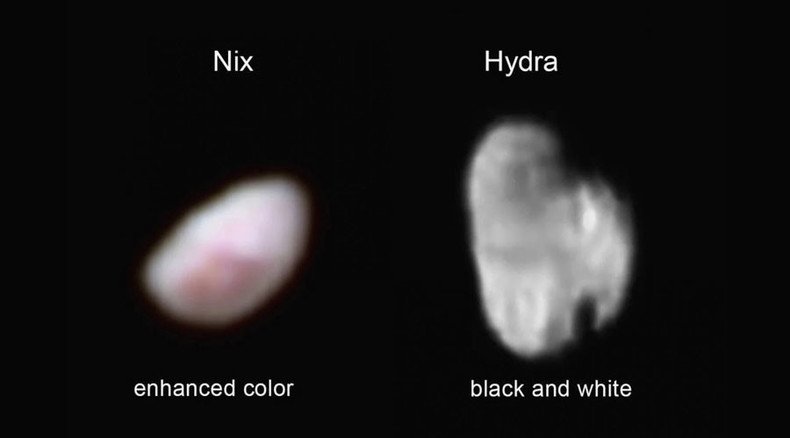Red ‘jelly bean’ satellite of Pluto found in latest New Horizons photographs

NASA released the most recent photos from the New Horizons probe’s recent Pluto flyby on Tuesday, revealing more details about the surfaces of the moons of the dwarf planet.
The probe’s flyby took place on July 14 and produced highly detailed images of Pluto that exceeded NASA’s expectations, as they showed off ice-covered mountain ranges and canyons. Pluto’s largest moon, Charon – which is half the size of its host planet – was even found to have its own ‘Mordor.’
Portrait of Pluto & its largest moon Charon! Images collected separately by @NASANewHorizons: http://t.co/FfTejETnwFpic.twitter.com/Gzp2P3VtDu
— NASA (@NASA) July 18, 2015Two smaller satellites of Pluto are also getting their moment in the sun now, since the spacecraft just took the best pictures of the bodies yet. Though the images of Nix and Hydra look pretty blurry, they are the most detailed images of the tiny moons that we’ve ever seen.
The difference in the fidelity of the images is due to the size and distance of the satellites. Nix and Hydra are 26 and 34 miles (42 and 55 km) long, respectively, and have an orbit that brings them much further out from Pluto than Charon.
Scientists are already using the images to make important conclusions about the astronomical bodies.
New Horizons captures first close-up image of Pluto's moon Nix http://t.co/YBE9lkr2Hrpic.twitter.com/3eEtfMtNs8
— The Verge (@verge) July 17, 2015Nix was determined to be approximately 26 miles long and 22 miles wide, and to have a distinctive red color and jellybean shape.
Hydra is estimated to be 34 miles long and 25 miles wide, and shaped like Michigan, with color differences that hint at the variations in material composition of the satellite, according to the Washington Post.
“Additional compositional data has already been taken of Nix, but is not yet downlinked," mission scientist Carly Howett said in a statement, reported the Post. "It will tell us why this region is redder than its surroundings. This observation is so tantalizing, I’m finding it hard to be patient for more Nix data to be downlinked.”
NASA expects to release photos of Pluto’s even more obscure moons, Styx and Kerberos, in October.













